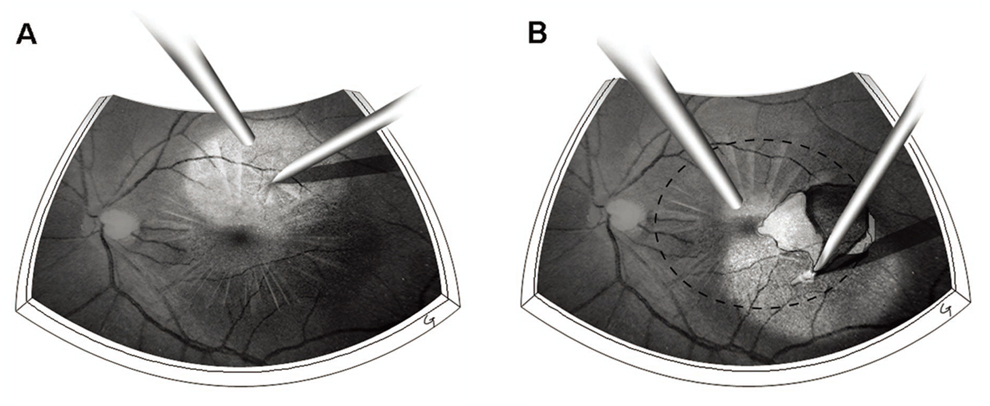Korean J Ophthalmol.
2008 Sep;22(3):169-173. 10.3341/kjo.2008.22.3.169.
OCT-guided Hyaloid Release for Vitreomacular Traction Syndrome
- Affiliations
-
- 1Department of Ophthalmology, NHIC Ilsan Hospital, Gyounggi-do, Korea.
- 2Kim's Eye Hospital, Gonyang University, Seoul, Korea.
- 3Yonsei Eye Clinic, Daejeon, Korea.
- 4The Institute of Vision Research, Department of Ophthalmology, Yonsei University College of Medicine, Seoul, Korea. hjkoh@yuhs.ac
- KMID: 1070752
- DOI: http://doi.org/10.3341/kjo.2008.22.3.169
Abstract
- PURPOSE: To evaluate the usefulness of OCT retinal mapping in determining the configuration of a vitreomacular adhesion and selecting a meridian for entry into the subhyaloid space in patients with vitreomacular traction syndrome. METHODS: Six consecutive patients (6 eyes) with vitreomacular traction syndrome underwent vitrectomy with peeling of posterior hyaloid. Ocular coherence tomography (OCT) retinal mapping was performed preoperatively. Access to the subhyaloid space was made by creating an opening with a 25 gauge needle at a location where the detached posterior hyaloid membrane was farthest from the retinal surface. The location was selected based on six preoperative meridional OCT scans. The posterior hyaloid was then gently peeled off in a circular fashion around the fovea with a micropick. Visual acuity and foveal thicknesses were measured before the operation and 3 months afterwards. RESULTS: After the operation, visual acuity improved and central macular thicknesses were reduced significantly in all six patients. The best corrected visual acuity improved from 0.4 to 0.75 with a mean increase by 3.5 lines on a Snellen chart 3 months after the operation. The mean foveal thickness was reduced from 406 micrometer to 241 micrometer. The restoration of foveal pit was observed in five patients. Neither intraoperative nor postoperative complications were observed during the follow up period. CONCLUSIONS: An OCT retinal mapping program is a valuable diagnostic tool in understanding the configuration of vitreomacular adhesion and planning the surgical approach for operating on vitreomacular traction syndrome.
MeSH Terms
Figure
Reference
-
1. Reese AB, Jones IS, Cooper WC. Macular changes secondary to vitreous traction. Am J Ophthalmol. 1967. 64:544–549.2. Reese AB, Jones IS, Cooper WC. Vitreomacular traction syndrome confirmed histologically. Am J Ophthalmol. 1970. 69:975–977.3. Jaffe NS. Vitreous traction at the posterior pole of the fundus due to alteration in the vitreous posterior. Trans Am Acad Ophthalmol Otolaryngol. 1967. 71:642–652.4. Smiddy WE, Michels RG, Green WR. Morphology, pathology, and surgery of idiopathic vitreoretinal macular disorders. A review. Retina. 1990. 10:288–296.5. McDonald HR, Johnson RN, Schatz H. Surgical results in the vitreomacular traction syndrome. Ophthalmology. 1994. 101:1397–1403.6. Smiddy WE. Yanoff M, Duker JS, editors. Vitreomacular traction syndrome. Ophthalmology. 2004. 2nd ed. St. Louis: CV Mosby;chap. 130.7. Hikichi T, Yoshida A, Trempe CL. Course of vitreomacular traction syndrome. Am J Ophthalmol. 1995. 119:55–61.8. Sulkes DJ, Ip MS, Baumal CR, et al. Spontaneous resolution of vitreomacular traction documented by optical coherence tomography. Arch Ophthalmol. 2000. 118:286–287.9. Kusaka S, Saito Y, Okada AA, et al. Optical coherence tomography in spontaneously resolving vitreomacular traction syndrome. Ophthalmologica. 2001. 215:139–141.10. Smiddy WE, Michels RG, Glaser BM, deBustros S. Vitrectomy for macular traction caused by incomplete vitreous separation. Arch Ophthalmol. 1988. 106:624–628.11. Margherio RR, Trese MT. Margherio AR, Cartright K. Surgical management of vitreomacular traction syndromes. Ophthalmology. 1989. 96:1437–1445.12. Melberg NS, Williams DF, Balles MW, et al. Vitrectomy for vitreomacular traction syndrome with macular detachment. Retina. 1995. 15:192–197.13. Koerner F, Garweg J. Vitrectomy for macular pucker and vitreomacular traction syndrome. Doc Ophthalmol. 1999. 97:449–458.14. Gallemore RP, Jumper JM, McCuen BW 2nd, et al. Diagnosis of vitreomacular adhesions in macular disease with optical coherence tomography. Retina. 2000. 20:115–120.15. Uchino E, Uemura A, Doi N, Ohba N. Postsurgical evaluation of idiopathic vitreomacular traction syndrome by optical coherence tomography. Am J Ophthalmol. 2001. 132:122–123.16. Ito Y, Terasaki H, Mori M, et al. Three-dimensional optical coherence tomography of vitreomacular traction syndrome before and after vitrectomy. Retina. 2000. 20:403–405.17. Massin P, Vicaut E, Haouchine B, et al. Reproducibility of retinal mapping using optical coherence tomography. Arch Ophthalmol. 2001. 119:1135–1142.18. Larsson J. Vitrectomy in vitreomacular traction syndrome evaluated by ocular coherence tomography (OCT) retinal mapping. Acta Ophthalmol Scand. 2004. 82:691–694.19. Gaucher D, Tadayoni R, Erginay A, et al. Optical coherence tomography assessment of the vitreoretinal relationship in diabetic macular edema. Am J Ophthalmol. 2005. 139:807–813.20. Yamada N, Kishi S. Tomographic features and surgical outcomes of vitreomacular traction syndrome. Am J Ophthalmol. 2005. 139:112–117.21. Johnson MW. Tractional cystoid macular edema: a subtle variant of the vitreomacular traction syndrome. Am J Ophthalmol. 2005. 140:184–192.
- Full Text Links
- Actions
-
Cited
- CITED
-
- Close
- Share
- Similar articles
-
- Diagnosis and Treatment of Vitreomacular Traction Syndrome Using Optical Coherence Tomography
- Clinical Manifestation and Result of Vitrectomy of Vitreomacular Traction Syndrome
- Spontaneous Resolution of Cataract-related Acute Vitreomacular Traction Syndrome
- Comparison of the Efficacy between Time and Spectral Domain Optical Coherence Tomography for the Identification of Vitreomacular Interface
- The Short-term Effect of Triple Therapy for Diabetic Macular Edema With Vitreomacular Traction



